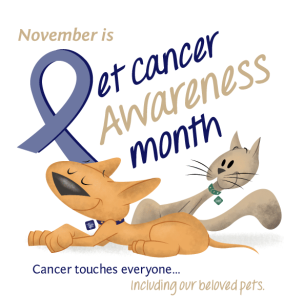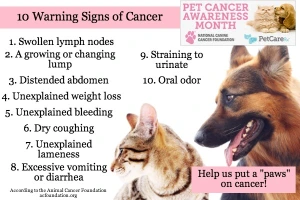For humans, cancer awareness months are well-known. When you see a pink ribbon, you know what that means. I don’t think there are many people who have not had their lives touched by cancer in one way or another. In the veterinary community, we are trying to bring awareness to the fact that pets get cancer too. In fact, cancer is the leading cause of death in pet cats and dogs in the United States. As many as 50% of pets die of cancer. While some of these cancers are deadly, some may be cured with early recognition and intervention. Some types may actually be prevented with simple elective surgery.
According to the AVMA, early (before 12 months of age) spaying of female dogs and cats will significantly reduce the risk of breast cancer. In addition, neutering a male pet can also reduce the risk of him developing testicular or prostate cancer.
Here are the top 10 warning signs of cancer in pet animals:
1. Abnormal swellings that persist or continue to grow. Pet your pet!!! This is the best way to find lumps, bumps or swellings that could be anywhere on the body. I recommend that once a month, when you give your dog or cat their heartworm preventative, you run your hands all over them. Look in their ears, in their mouth, between their toes, under their tail. This will help you pick up any new lumps or bumps very early.
2. Sores that do not heal. Non-healing sores can be a sign of infection or cancer. Your veterinarian can determine the reason why the sore is not healing.
3. Weight loss. If your pet is not on a diet but is losing weight, illness could be to blame.
4. Loss of appetite. Most pets are VERY food motivated. It is not normal for pets to lose their appetite. Often, this subtle sign is one of the first things noticed when a pet is very ill.
5. Bleeding or discharge from any body opening. Bleeding can occur for numerous reasons — most of which are abnormal. Vomiting and diarrhea are abnormal “discharges” as well.
6. Offensive odor. This is a common sign for tumors in the mouth, nose or anus.
7. Difficulty eating or swallowing. This is a common sign of cancers of the mouth and neck region.
8. Hesitation to exercise or loss of stamina. This can be one of the first signs that your pet is not feeling well.
9. Persistent lameness. There could be many causes of lameness, including nerve, muscle or bone cancer.
10. Difficulty breathing, urinating or defecating. These are often emergent situations and may signify more advanced disease.
(Source: http://www.csuanimalcancercenter.org)
Your pet should be seen by a veterinarian immediately if you notice any of these signs. The earlier cancer is diagnosed, the better the options may be for treatment. Just like humans, pets should get regular “well-pet” check-ups to monitor their health. The American Veterinary Medical Association, American Animal Hospital Association and the American Association of Feline Practitioners all strongly recommend examinations every six to twelve months for all pets. Many of these organizations also advocate regular wellness screenings including complete blood counts and blood chemistry panels. These tests can help us diagnose potentially life threatening illnesses such as cancer very early.


